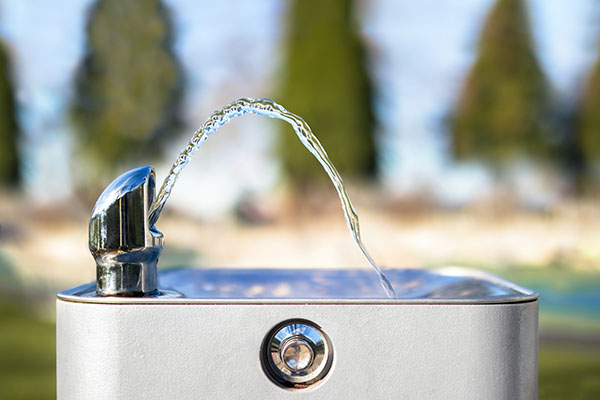

Water Testing and Safety Tips for Drinking Fountains
By Grainger Editorial Staff 7/1/19


Ever since the water crisis in Flint, Michigan, clean water has been on many of our minds. Many of us assume that our water is safe to drink, and never give it another thought. What we have learned, however, is that without regular water testing, there is no way to ensure that our water is as clean and safe as we believe it to be.
What Is in the Water ?
There are two factors that can change the safety of your water source. The first is your pipes. What kind of pipes does your water run through? What material are they made out of? How old are they? Have they been well-maintained? These factors can affect if any metals or other debris are in your drinking water. Municipal agencies are responsible for making sure that the water pipes that bring public water into your facility are well-maintained and safe. However, it is the responsibility of the building owners to ensure that the indoor plumbing is safe.
The second factor is on the outside of your water source—that is, the drinking fountain or faucet itself. These can be breeding grounds for bacteria that you may not even be aware of. The more people that come into contact with its surface, the more likely it becomes that you have bacteria. This is an especially high concern if you run a school or daycare center. In some studies, it has been shown that a school’s drinking fountain contained more bacteria than the toilet. If the water from that fountain comes into contact with the surface bacteria, you have tainted water.
What Are the Possible Effects?
The negative effects of having contaminated water, of course, depend on what your water is contaminated with. Lead poisoning, for example, can cause damage to many of your internal organs. It can also affect your blood cells, as well as interrupt kidney function. Long-term exposure to high levels of copper can also be damaging, though copper poisoning from pipes is less common than lead.
A high bacteria content on, in, or around your water source can cause several other issues. This all depends on the kind of bacteria is present on the water source, and how much of it is coming into contact with the water. Water fountains in day care centers and schools were frequently found to have rotavirus on them, as well as strains of the common cold and the flu.
What Can Be Done?
The best way—in fact, the only way—to know what is in your water is to have it tested. There are water testing agencies all over the country that can give you a professional assessment of your facility’s water, and if there are any risks or contaminants you should know about. If you are ready to have your water tested, the EPA has made it easy to find a water testing agency in your area. It is best practice to have your water tested at least once a year. You should also have it tested if you or another facility near you is under construction, as this may loosen debris from the pipes and release it into your drinking water.
There are also do-it-yourself water testing kits available if you want to get a quick and easy sample of what kind of contamination you may be looking at. While these are no substitute for a professional assessment, they can give you an idea of how much bacteria are on that water cooler in the break room.
Clean for Clean Water
Contaminants that come from pipes or other sources before they even get to your spigot must undergo professional processing to be fixed. However, keeping the bacteria out of your drinking materials is as easy as making sure it is properly maintained.
- Water fountains—especially those in facilities with children—should be cleaned at least once a day.
- The entire fountain surface, including the mouthpiece, protective guard, basin and handles, should be scrubbed with disinfectant. They should then be wiped down with a clean, damp cloth.
- Inform your staff and others who use your drinking fountains that they should let the water run for two or three seconds before taking a drink. This can help rinse off some of the bacteria before you take it in.
Community fountains and coolers are great for providing your facility with water, and also for bringing people together. Just make sure yours are as clean as they are refreshing.
Sources:
http://articles.mercola.com/sites/articles/archive/2015/09/26/drinking-fountain.aspx
http://www.in.gov/idem/files/lead_epa_schools_pws.pdf
http://abcnews.go.com/GMA/story?id=3293080&page=1
https://www.epa.gov/dwreginfo/testing-schools-and-child-care-centers-lead-drinking-water
https://www.epa.gov/privatewells/protect-your-homes-water
http://lifehacker.com/5927732/afraid-of-contamination-how-to-test-the-water-in-your-house
http://www.mayoclinic.org/diseases-conditions/lead-poisoning/basics/symptoms/con-20035487
https://medlineplus.gov/ency/article/002496.htm
![]()
The information contained in this article is intended for general information purposes only and is based on information available as of the initial date of publication. No representation is made that the information or references are complete or remain current. This article is not a substitute for review of current applicable government regulations, industry standards, or other standards specific to your business and/or activities and should not be construed as legal advice or opinion. Readers with specific questions should refer to the applicable standards or consult with an attorney.






